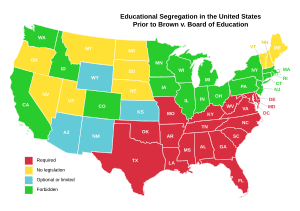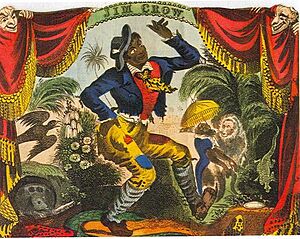Separate but equal facts for kids
Separate but equal was a legal idea in the United States that lasted for 58 years. It came from a decision by the U.S. Supreme Court in a case called Plessy v. Ferguson.
In that case, the Court said that separating people by race (called racial segregation) was not against the Fourteenth Amendment to the United States Constitution. This was true as long as the separate places, like schools or train cars, were considered "equal." The Court also said that segregation was not discrimination.
This idea made segregation legal in public places, on transportation, and in schools. This continued until 1954, when the Supreme Court changed its mind in the case of Brown v. Board of Education.
What Happened Before
After the American Civil War, the Republican-controlled Congress passed three important changes to the U.S. Constitution. These are known as the Reconstruction Amendments.
The first was the Thirteenth Amendment to the United States Constitution, which ended slavery in the United States. The second was the Fourteenth Amendment to the United States Constitution. This amendment said that all citizens should have equal protection under the laws. The third was the Fifteenth Amendment to the United States Constitution, which gave African American men the right to vote.
After these amendments, life became harder for black people in the South. Many white people did not want to accept these new changes. Groups that believed in white supremacy, like the Ku Klux Klan, formed. They used violence to scare African Americans and stop them from using their new rights.
In 1875, Congress passed the Civil Rights Act of 1875. This law was meant to make sure African Americans were treated equally in public places and on public transportation. It also aimed to prevent them from being kept off juries. However, a few years later, the Supreme Court decided that parts of this law were unconstitutional. The Court said the Fourteenth Amendment stopped states from discriminating, but not individuals. So, Congress could not protect against discrimination by individuals.
The Plessy v. Ferguson Case
Florida was the first state to pass a law saying that railroads had to have "equal but separate accommodations for the white, and colored, races." Soon, other states like Texas and Mississippi passed similar laws.
In 1890, when Louisiana passed a similar law, black people started to fight back. In 1892, a plan was made for Homer Plessy to challenge these laws. Plessy, who looked white, rode in the "white section" of an East Louisiana train. He then announced he was black and refused to move to the "colored" section.
Plessy was arrested, and in 1896, his case went to the Supreme Court. The case was called Plessy v. Ferguson, named after the judge who first ruled against him.
Plessy's lawyers argued that Louisiana's Separate Car Act went against the Thirteenth and Fourteenth Amendments. However, the Supreme Court, in a 7-1 decision, ruled against Plessy. They said the law was constitutional.
Justice Henry Brown wrote for the majority:
"A law that just means there's a legal difference between white and colored races doesn't destroy their legal equality. ... The Fourteenth Amendment was meant to make both races equal before the law. But it wasn't meant to get rid of differences based on color, or to make social equality instead of political equality, or to mix the two races if they didn't want to."
The only judge who disagreed was Justice John Harlan. He believed this decision would have terrible results. He wrote:
"Our Constitution treats everyone the same, no matter their color, and doesn't allow for different classes of citizens. When it comes to civil rights, all citizens are equal under the law. ... This decision, it's feared, will not only lead to more attacks, some brutal, on the rights of colored citizens, but will also make people believe that states can stop the good goals the United States had when they added the recent changes to the Constitution."
The big problem with the Plessy decision was that "separate" was almost never truly "equal." Public schools and other places for black people were almost always worse than those for white people.
The Jim Crow Era
Starting in 1890, politicians in the South began to pass state laws that took away the rights African Americans had gained. These racist laws became known as Jim Crow laws. Because of the Plessy decision, these Jim Crow laws were not stopped by the federal government for 58 years.
These laws made it very hard or impossible for black people to vote. Since they couldn't vote, black people also couldn't be on juries. Other laws demanded racial segregation. This meant black people could not go to the same schools, restaurants, or hospitals as white people. They couldn't use the same bathrooms or drink from the same drinking fountains. They also couldn't sit in the front of buses or trains if white people were present.
Many southern Christian ministers taught that white people were special and black people were cursed. Violence was used to scare black people and keep them from challenging these rules.
Images for kids
-
"We cater to white trade only." A restaurant in Lancaster, Ohio, in 1938.
-
A "colored" drinking fountain in Oklahoma City, 1939.
See also
 In Spanish: Separados pero iguales para niños
In Spanish: Separados pero iguales para niños






